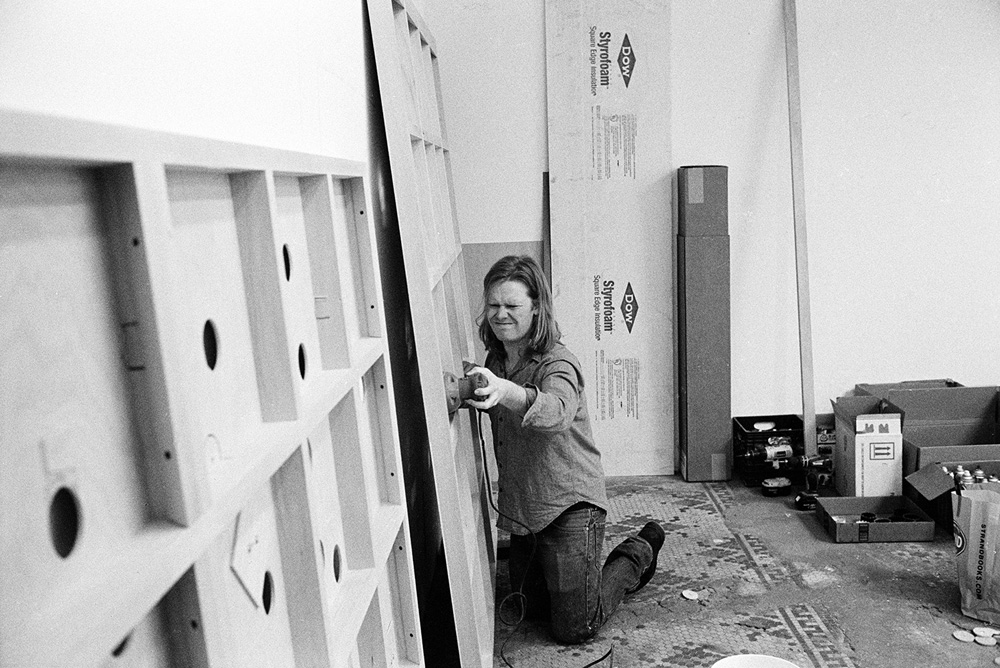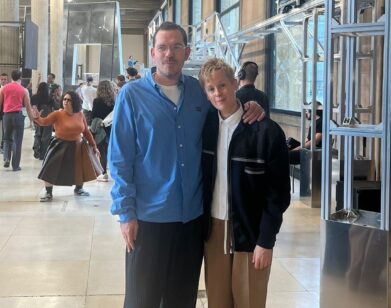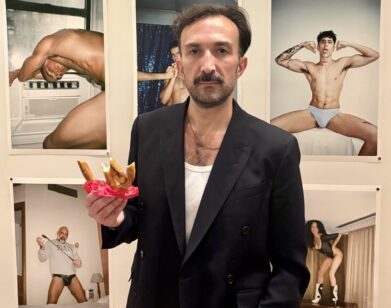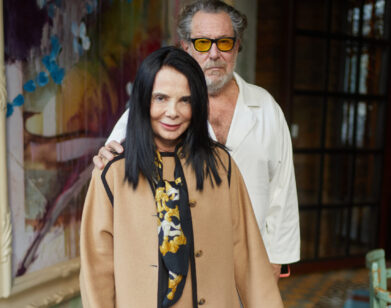The Purity of Plywood
Plastic caps, the remnants of empty spray paint cans, punctuate the surface of Dylan Bailey’s large-scale panels of plywood. Standing nearly seven feet tall, Bailey’s panels examine the production of industrial materials and our dependency on them. With each work in this series, the Brooklyn-based artist develops a new layout—some panels present a sparse arrangement of caps, while others favour a directional, weighted composition.
In advance of his first solo show at David Nolan Gallery, which opens tomorrow, Bailey spoke with fellow artist Aaron Bobrow about DIY plywood projects from the 1950s and the parallels between abandoned spray paint caps and Budweiser empties. —Amy Davis
AARON BOBROW: Hey, Dylan, would you talk a little bit about how you see the relationship between the plywood and the spray paint caps in your newest works?
DYLAN BAILEY: Let’s see, the plywood and the spray paint caps. Well, as far as the plywood goes, I was just trying to approach the traditional support. Originally, I just started with cardboard as a stand-in. It worked for a while, but there were limitations; it didn’t hold up.
BOBROW: In terms of durability?
BAILEY: Yeah.
BOBROW: And precision?
BAILEY: And also the ease of working with it. At first I wanted to have something really slow to do, so I was cutting out these spaces by hand and then I got bored. I wanted something that I could drill and do faster, so that it became more about working with the color. So I switched to the plywood. I became interested in the fact that I could paint the wood; I could do these different things to it. It could be MDF, or a different material. I liked that the natural wood grain acted as a juxtaposition to the other elements. I wanted to keep the sentiment of the cardboard as a kind of natural element in a way. I wanted to use the most straightforward material.
BOBROW: There’s also a warmth with the wood.
BAILEY: Yeah. There’s a naturalism.
BOBROW: …and a loaded history with the plywood.
BAILEY: Yeah, both components are 20th-century materials. Spray paint from the ’50s. I think the first spray paint was made at the turn of the century, but commercial aerosol paint became available in the ’50s.
BOBROW: It came from the Midwest, right? From Illinois?
BAILEY: The major companies were from the Midwest, yeah. And plywood is kind of a similar thing. They’re both these modern, industrial American inventions.
BOBROW: I read today that the oldest plywood is Egyptian, but that the first recognized patent was American, in New York. It also has a pretty strong association with World War II.
BAILEY: Yeah, it has. I guess I was thinking of it in terms of contemporary design, plywood was embraced by people in northern Europe and Bauhaus design. That was its first use in mass production. All those guys used plywood for furniture.
BOBROW: Things for the house
BAILEY: Things for the home, yeah. And as a building material. [reaches for papers] I think you’d like this. The United States Plywood Corporation. This document was released after an exhibition of one of Frank Lloyd Wright’s early model homes—this lists all the different plywood materials he used. It says: “the floors are Novotile tiles, a new flooring material also a U.S. Plywood product. In fact all of the house except for the brickwork is built of plywood, because plywood, says Mr. Wright, is what the machine has given us at its best. Much of the innate beauty of nature as it applies to wood lay hidden and it wasn’t unravelled until the machine remedied it. Plywood is the liberation of wood.”
BOBROW: It streamlined it.
BAILEY: Right, but it’s also interesting that wood in its natural state is not as good as wood in an industrialized state. And in terms of aesthetic value, plywood is a utilitarian thing, but the aesthetic that’s revealed as it is processed makes it better than wood in it’s natural, un-machined state.
BOBROW: Do you want to talk a little but about what attracted you to spray paint in general? Besides your illustrious career as an all-city bomber?
BAILEY: [laughs] Yeah. With spray paint, I think it comes from—
BOBROW: Availability? Immediacy?
BAILEY: Exactly.
BOBROW: Color choices?
BAILEY: The limited choices, all of the great things about it. It dries quickly. It goes on all almost anything.
BOBROW: I read somewhere that the guy who invented spray paint did it for the purpose of repainting his radiator.
BAILEY: Yes.
BOBROW: So it’s funny because we really think of spray paint, in New York, as something that’s on the exteriors, on the facades and on the trains and throw ups. But the other side of the coin for spray paint is that it’s for people who want to do domestic jobs. They’re not lazy, but they want to get back to their day. They’re looking for good paint coverage. Whereas in New York, we spend so little time in our homes; we spend so much time on the street. But most of the time you’re going to see [spray paint] on your uncle’s garden furniture. Or on some set of dining room chairs that’s sitting in your garage.
BAILEY: Or on a yard-sale sign, or on any kind of do-it-yourself project, which became big in the ’50s. “Weekend Warrior” stuff took off post-war, because people had more free time.
BOBROW: It was the first time that ever had existed.
BAILEY: All these hobbies.
BOBROW: This utilitarian luxury.
BAILEY: Exactly.
BOBROW: And I think it has to do a lot with the availability of space in our country, as opposed to Europe. Here, there’s tons and tons and tons of space.
BAILEY: Right, with two-car garages. I have this amazing book, Plywood Working for Everyone. It’s weekend projects you can build out of a four-by-eight-foot sheet. So maybe you could build a darkroom cabinet…
BOBROW: [laughs] Right, and you just order the enlarger via a catalogue, from JC Penney.
BAILEY: The designs are awesome. They are totally stuff you want. This material defines the modern interior.
BOBROW: Definitely. Where do the caps fit into the plywood for you? Is it sort of a pragmatic thing, or availability of materials? Where and how do they combine for you?
BAILEY: I started with the caps as a by-product from my paintings.
BOBROW: What was left over.
BAILEY: Yeah, the leftovers… how do I recycle this stuff? I’d be painting and the spray can tops would be everywhere, useless. When people do graffiti, and carry the cans around in their backpacks, they never keep the tops on.
BOBROW: But they are useful in one way, because they are a color—they tell you what color it is. So they’re representative of what’s inside.
BAILEY: There is a relationship between the cap and the color inside. But you don’t put them back on, you just look at the drips of paint that come down off the can to tell what color it is, or you just spray it and then see. I had all these caps lying around and I just started saving them, as I do sometimes—I like to save things like that—and I liked that they were just these bits of raw color; the plastic is the color, it’s not painted the color.
BOBROW: It’s pure.
BAILEY: Right, it is a pure piece of the color.
BOBROW: We’re not talking Pantone chips here.
BAILEY: No, we’re not. But for what it is, it is a Pantone chip. If you look at a color swatch at a paint shop, it’s the same thing. It’s just an object of pure color. When Josef Albers would instruct his students, he had them use colored paper rather than mixing paint, which has its benefits: you can repeat the use of exactly the same color, it’s cheaper, easier, more orderly. It avoids unnecessary mixing of paint. In the case of the spray tops, there is an elegant economy in these pieces of plastic.
Regarding the cap and the can of paint—I like thinking about their relationship because the caps are sort of a mold of the actual can, a counter-relief.
BOBROW: Like a plus or a minus. They’re the receiving, so they are the feminine.
BAILEY: A similar proximity.
BOBROW: Especially if they’re recessed and flushed. Do you want to talk a little bit more about recycling the caps and using what was available to you in your studio? You know, you could have cut these out and put basketballs or grapefruits, but you chose to do what was there, stuff that you had already used. I think there’s a relationship to the idea of Native Americans hunting their prey and using every part of it, and now the idea in contemporary food culture of nose-to-tail eating—the idea of using the leftover scraps to find new flavors or find a new way to converse with the history of painting and sculpture.
BAILEY: Well, obviously I think that’s hugely important. I’ve always worked with modular forms, and that’s sort of a modern way of working—Buckminster Fuller-esque. Any time I’m accumulating something, I’m re-imagining these objects. I’m constantly saving that kind of detritus to use in a future process. Making more from less, in a way.
BOBROW: But also a cap or a piece of packaging, whether it’s a beer can or a spray can, all of those things are tailor-made and are designed to contain and deliver a finite quantity. Once you use what you’ve purchased, whether you empty the can of spray paint or you finish drinking the beer, what’s left of it is this indexical trace, a trace of having been there, of consumption. There’s a by-product and finding meaning in those by-products speaks to the idea of equivalency and of positive and negative values.
BAILEY: Diagrammatical or equivalent relationships.
BOBROW: Totally.
BAILEY: I’m not trying to invent something new. This body of work isn’t about using something new. It’s about reusing something.
BOBROW: A tidy graveyard.
DYLAN BAILEY’S SOLO SHOW OPENS TOMORROW, APRIL 4, AT DAVID NOLAN GALLERY IN NEW YORK AND IS ON VIEW THROUGH MAY 20.







